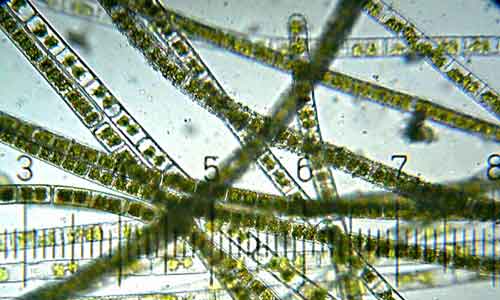Algae are photosynthetic microorganisms that perform photosynthesis and produce oxygen (O2) and consume carbon dioxide (CO2) from the atmosphere. During photosynthesis, algae produce at least half of the oxygen in Earth’s atmosphere. Most of the algae inhabit the aquatic environment, either freshwater or marine habitats. They can also occupy on rocks, soils, vegetation, or moist terrestrial habitats. Some marine algae use as seafood, while some algae produce toxins. Structure of algae consists of cellular and vegetative structure.
Vegetative Structure of Algae
The vegetative structures (thallus) of algae vary from species to species. They may be simple unicellular to complex multi-cellular. Their size ranges from small as less than 2 micrometers (Micromonas) to large as 30-60 meters long (Macocyctis, a type of marine algae). The following are the diverse vegetative structures of algae:
Unicellular motile: The body consists of a single cell. In these algae, movement takes place by flagella, such as Chlamydomonas.
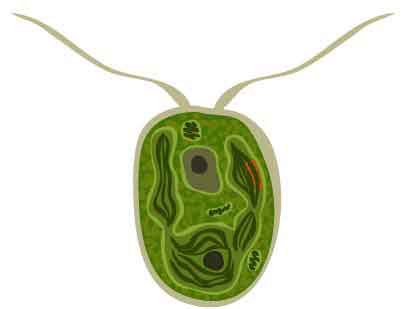
Unicellular non-motile: They are single-celled round algae. They exist as solitary or in the group within mucilage covering. Examples: Chlorella, Gloeocapsa, etc.
Motile colonial: In this case, definite numbers of unicellular algae form colony and they are motile. This type of colony is known as a motile colony. Examples: Volvox.
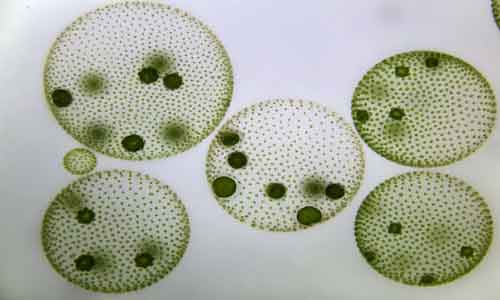
Non-motile Colonial: In colonial forms, the number of unicellular algae is indefinite, and they are non-motile such as Scenedesmus, Hydrodictyon (water net), etc.
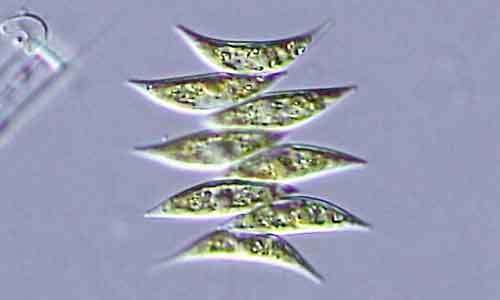
Palmelloid type: In this case, algae cells are surrounded by a viscous mucilaginous substance such as Teyraspora, Aphanothce, etc.
Dendroid type: In this case, cells produce a mucilaginous substance, and they are folded in such a manner that they look like branches of a plant such as Prasino cladus.
Filamentous: These types of algae are of two types: Among them, some are simple un-branched filamentous such as Ulothrix, Spirogyra, and some are simple branched filamentous such as Cladophora.
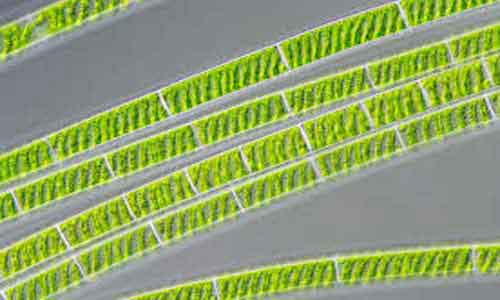
Heterotrichous: Thallus of the algae consists of the following two parts: main shoot or trichome, which runs horizontally, termed as a prostrate system and a vertical erect trichome or shoot termed as erect system. This type of body is known as a heterotrichous form.
Parenchymatous: In these algae, cell division takes place on different sides, with the result that they become parenchymatous such as Ulva.
Siphonous: These algae consist of the multinucleate tube-like cells having no septa such as Vaucheria, Polysiphoni, etc.
Nodous: In this case, algae bodies contain nodal and intermodal areas such as Chara.
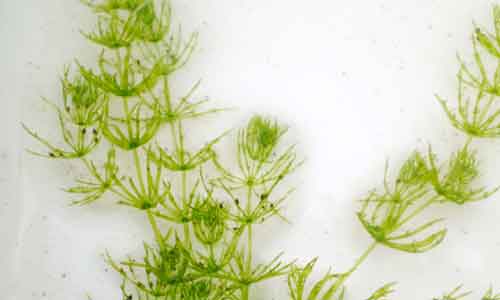
Complex: In this case, algae look like multi-cellular plants — the body divisible into holdfast, stipe, and frod, such as Sargassum, Laminaria.
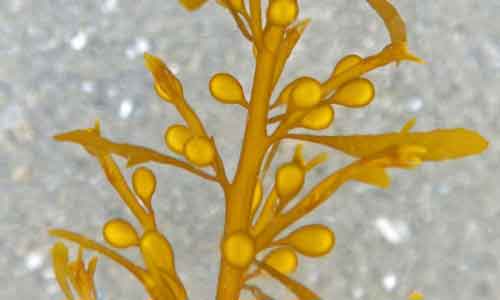
Cellular Structure of Algae
The algal cells consist of the following structures:
Cell wall
Most of the algal cells have a cell wall. Some flagellated algae are lacking a cell wall. Algae cell-wall consists of two layers: inner microfilamentous and outer gelatinous irregular layer. Chemically, the cell wall is composed of cellulose, pectin, mucilage like a carbohydrate. It also contains other substances like alginic acid, calcium carbonate, fucoidan, fucin, silica, etc. The thickness of the cell wall varies with variously oriented in a granular matrix. In some cases, cell wall bears stored protein. Unicellular diatom algae have strong, rigid, siliceous ornamental, two valves cell walls. The siliceous ornamental cell wall is called frustule. The cell wall of the members of Cyanophyceae contains mucopeptide. In certain algae such as Gymnodinium and Pyramimonas, a true cell wall is absent. In this case, the cell is bounded by a membrane, known as a pellicle.
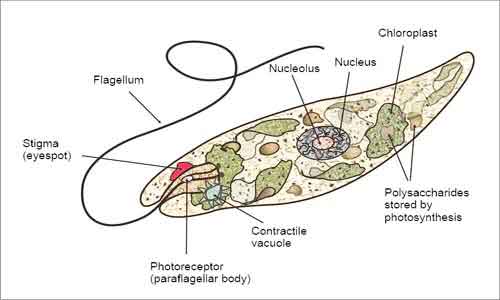
Plasma membrane
It occurs below the cell wall. The structure of the algal plasma membrane is like other eukaryotic cells. Some filamentous algae lack cell wall having stout and strong plasma membrane. This type of plasma membrane is known as periplast.
Protoplast
The eukaryotic algal protoplasm consists of one or more nucleus and cytoplasm. The cytoplasm is divided into cytosol and cell organelles. The protoplasm is bounded by lipoproteinaceous cell membrane, which is fluid mosaic in nature. The membrane is elastic and very thin, with selectively permeable in nature. It performs to control the passage of materials in and out of the cells. The algae have well organized spherical or elliptical shaped nucleus, which is surrounded by a distinct and double layer nuclear membrane. In this case, the outer membrane is attached to the endoplasmic reticulum(ER), while the inner membrane contains a matrix or karyolymph with chromatin reticulum.
The numbers of nucleoli or endosomes vary in different algal cells with varying numbers of chromosomes. Porphyra linearis contains the lowest numbers of chromosomes (n=2), while the highest numbers of chromosomes are found in Netrium digitali (n=592).
Cells Organelles
Like other eukaryotic cells, eukaryotic algal cells have membrane-bound cell organelles like chloroplasts, mitochondria, Golgi apparatus, ribosomes, endoplasmic reticulum, and in some cases, eyespot or stigma. In the prokaryotic algal cell, the nucleus is not surrounded by a membrane. In this case, the protoplasm is separated by photosynthetic pigments containing outer peripheral chromoplasm and colorless inner centroplasm.
Nucleus
Most of the algal cells are uni-nucleated, but in some cases, they are multinucleated.
Plastids
Algal cells have colorful plastids, the chloroplasts. It is the prominent feature which is bounded by double-membrane structure; their number and shape vary in different species.
The chloroplasts of algae have various forms and shapes; in algae, eight main types are recognized: discoid (Chara), cup-shaped (Volvox), parietal, spiral (Spirogyra), C-shaped or girdle shaped (Ulothrix), reticulate (Oedogonium), ribbed (Volvocales), and stellate (Zygnema).
The chloroplast contains the following three major structural regions:
Envelope: It is the two membranous enclosed spaces.
Stroma: It is a very important structure that helps to store starch and contains enzymes for protein synthesis and metabolism.
Internal lamellar membranes: It is a highly organized membrane that contains different types of pigments for capturing energy. This lamellar system forms sac-like discs or thylakoid, which are stacked together and form grana. This thylakoid provides space for the chlorophyll a and other accessory pigments.
In most cases, chloroplasts have a glycoprotein structure, known as a pyrenoid. Chloroplasts of all kinds of algae have photosynthetic chlorophyll pigments which provide the actual color of the thallus.
In algae, five types of chlorophylls are found (Chlorophyll a, b, c, d, and e). Among them, chlorophyll a is found in all groups of algae, while chlorophyll b is present only in Chlorophyceae. Chlorophyll c is located in the representatives of Bacillariophyceae Cryptophyceae, Chryso-phyceae, and Phaeophyceae, chlorophyll d is seen in some red algae, and chlorophyll e is found in certain Xanthophyceae.
Besides chlorophyll, they also show various carotenoid pigments that impart different colors to algae as blue phycocyanin, yellow-brown fucoxanthin, brown phaeophycin, red phycoerythrin, etc. In this case, carotenoids are composed of carotenes and xanthophylls. In algal cells, the following five types of carotenes are found: α-carotene, β-carotene, c-carotene, e- carotene, and flavacene.
Besides carotene, several types of xanthophylls are found, such as lutein, violaxanthin, neoxanthin, fucoxanthin, myxoxanthophyll, myxoxanthin and oscilloxan. In this case, fucoxanthin is the main xanthophyll pigment.
In algae, phycobilins are also found as accessory pigments. They act as bilioproteins and provide either blue (phycocyanin) or red (phycoerythrin) in color. These types of pigments are found only in Rhodophyceae and Cyanophyceae, which absorb and transfer the light energy to the reaction center. Chloroplasts also contain proteinaceous bodies, known as pyrenoids. They perform to synthesize and store starch.
Reserve food
The staple reserve food of algal cells is carbohydrate. Different algae have different types of reserve carbohydrates. Green algae (Chlorophyceae) have starch, brown algae (Phaeophycea) have laminarin, and mannitol, yellow-golden (Chlorophytes) algae have volutin, red algae (Rhodophyceae) have Floridian starch as reserve food. Besides, these algae have oil and fat, leucocin, paramylum as reserve food.
Concluding Remarks
Algae are a diverse group and very familiar to most people. They play an important role in the freshwater environment and act as the base for the aquatic food chain supporting all fisheries in the inland and oceans. They also remove excess nutrients and pollutants from the water controlling eutrophication. In some cases, excessive growth of algae can cause harmful effects to aquatic environments.

